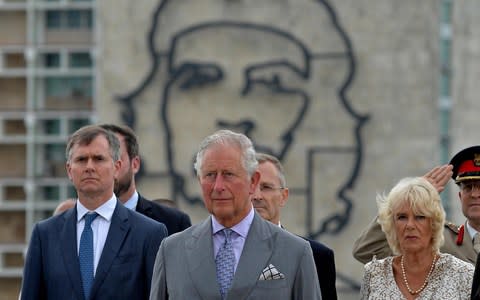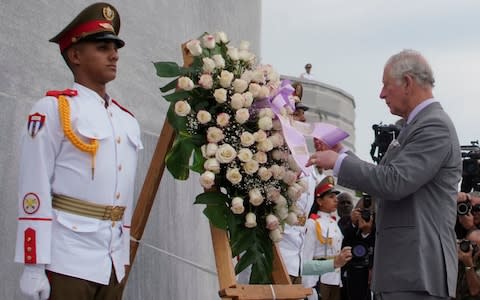Prince Charles pays respects to revolutionary hero in landmark visit to Cuba

Prince Charles paid his respects to one of Cuba’s revolutionary heroes after becoming the first royal to visit Cuba in 60 years with his wife Camilla, the Duchess of Cornwall.
Within an hour of touching down in Havana on Sunday night, the royal couple’s first official engagement was to lay a wreath at the monument to José Martí, Cuba’s national figurehead who became a symbol of the country’s bid for independence against Spain in the nineteenth century.
They landed in a British government RAF Voyager after spending the morning in Barbados, where they attended a service at St Michael’s Cathedral in Bridgetown.
After being greeted at Havana’s International Airport - also named after José Martí - by the Vice Minister of Foreign Affairs, Rogelio Sierra Diaz, Charles and Camilla were taken to the eponymous memorial.
Although he died in battle against the Spanish, leading a reckless cavalry charge at the battle of Dos Ríos in 1895, Martí was a poet and essayist as well as revolutionary thinker and political theorist.

At 109 metres, his memorial - a star-shaped tower made of Cuban marble - is said to be the largest monument in the world to a writer.
The prince and duchess stood at the base of the memorial flanked by a guard of honour while a military band played the two national anthems: first Cuba’s - words by José Martí, naturally - and then Britain’s.
As the couple stood there they were overlooked by the images of two heroes of the Cuban revolution behind them. One huge wire sculpture on the side of a government building depicted Che Guevara, another the revolutionary commander Camilo Cienfuegos.

The display of pink-tinged roses was brought up to Charles on an easel borne by two goose-stepping soldiers, who then placed it for him at the foot of the memorial. In Cuba, it seems, visiting dignitaries do not get to lay their own wreaths, but instead simply untie the ribbon around them.
The couple were then given a tour of the museum dedicated to Martí inside the monument.
Curator Eva Maria Diaz told him about the writer’s life, and the history of Havana, which prompted Charles to point out that Britain had once occupied the city during the eighteenth century - “briefly”.
As they left he told her: “I’ve learnt a great deal about José Martí.”
Saying that he would like to spend more time in Cuba, he joked: “You might get fed up with us very quickly.”
He added: “I am sorry to have dragged you in on a Sunday. I hope it is not inconvenient for you.”
She said afterwards: “He knew that Havana was under British power in the eighteenth century. It was a very brief period.
“He said that he would like to have more time to continue the visit. He was especially interested inJosé Martí's life and work. I told him that Martí's writings were published in 27 books, including literary, political and journalistic works.”

